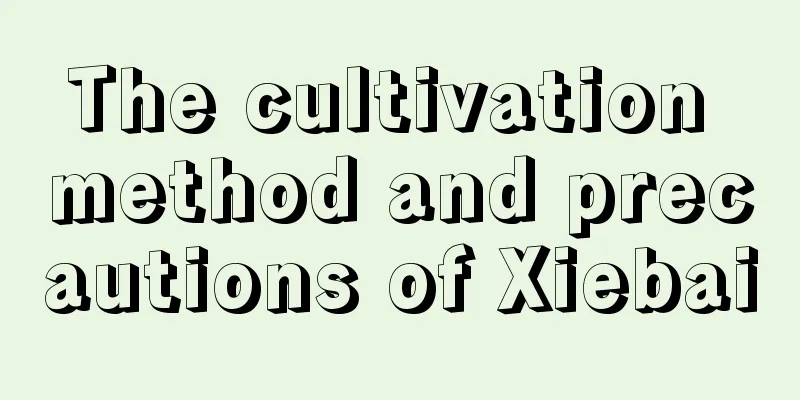Begonia cultivation methods and precautions

|
Some flower lovers say that begonias are difficult to grow. In fact, as long as there is a ventilated environment at home and bright scattered light, it is easy to grow. It is very suitable for indoor growth and can even be grown on the windowsill of the office. It has very bright flowers, and some varieties have colorful leaves. It is a plant for viewing leaves and flowers. How to grow begonias1. Temperature The best maintenance temperature for begonia is between 12-25 degrees. If the temperature is above 32 degrees, black stem rot and other problems will easily occur. The environment needs to be kept ventilated and shade measures should be taken. Begonia is very afraid of cold. If the maintenance temperature in winter is below 7 degrees, frostbite will easily occur. 2. Lighting When caring for potted begonias indoors, you can place them in an air-conditioned room to allow them to safely spend the summer. You can also move the potted plants to a cool, ventilated place in the summer, provide appropriate diffuse light, or even place them directly under the shade of a tree, with more than 3 hours of soft light a day. 3. Pot soil Begonias should use loose, fertile and well-drained soil, such as common peat soil, fine coconut bran and coarse coconut bran blocks, mixed in a ratio of 5:3:2. You can sprinkle some slow-release fertilizer in the potting soil. 4. Fertilization Begonias do not require much fertilizer. You only need to sprinkle some slow-release fertilizer on the potting soil in spring and autumn. If the temperature can be maintained between 15-25 degrees, you can add water-soluble fertilizer every 10 days or so, such as the common Huaduoduo No. 1 or Huaduoduo No. 2. You can spray them alternately, which can not only promote leaf growth, but also occasionally produce some small flowers. 5. Watering Begonias prefer an environment with high moisture content. After growing them into potted plants, do not let the soil in the pots dry out completely before watering, otherwise it will cause the begonias to wilt. When the environment is good, you can generally wait until the topsoil is dry and then water them thoroughly. Begonia flower care precautions1. Temperature: Begonia grows vigorously in spring and autumn. In the hot summer, begonia will enter a semi-dormant state or a state of slowed growth. It needs an appropriate amount of water spraying to cool down. When the temperature is below 5 degrees in winter, it must be moved to a warm indoor place for cultivation. 2. Light: Begonia can tolerate a semi-shaded environment, but it cannot be grown in an overly shaded environment, which will cause poor growth of the plant. It needs to be ensured that there are more than 3-6 hours of scattered light every day to allow it to grow healthily. 3. Fertilization: When fertilizing begonias, be careful not to apply fertilizers that only contain nitrogen, and do not give fertilizers that contain too much nitrogen, otherwise it will cause the stripes on the leaves to degenerate. When the temperature exceeds 25 degrees, stop fertilizing. |
<<: What are the breeding methods and precautions of Yamato Jin?
>>: Advantages and disadvantages of Monet rose
Recommend
How to identify the quality of passion fruit and how to preserve it for a longer time
1. Identification Method 1. Appearance: When buyi...
The New Year is almost here and while others are buying flowers, he buys "onion flowers". Those who make fun of him are all envious to death in the end!
“Onion head” No. 1: Daffodil! Narcissus is a trad...
How to grow black orchid vigorously
1. Shading Many varieties of this flower are afra...
How to Identify Peonies
1. Branches The flowering peony plant is in the s...
What fertilizer is good for Milan flowers?
The best time to fertilize Milan is during the gr...
What should I do if Xiuyan grows too tall?
1. What is leggy growth? This is a common phenome...
Is lavender a shade or sun-loving plant?
Does lavender prefer shade or sun? Lavender is a ...
Where does rice originally grow?
1. Place of Origin Its cultivation history can be...
How to propagate alum root
1. Division propagation After a period of growth,...
Why does the goldfish plant lose its leaves and how to remedy it
1. Reasons for leaf drop 1. The light is too stro...
Lemon planting conditions and temperature requirements in the planting area
Lemon Introduction Lemon is a plant of the genus ...
Can the lucky tree be propagated by cuttings? When can it be propagated by cuttings?
Can the lucky tree be propagated by cuttings? The...
How to grow cornflowers on the balcony and what to pay attention to
1. Lighting Cornflower is a long-day plant and ne...
How to use plant nutrient solution (correct use of flower and green plant nutrient solution)
Is the nutrient solution watered on the roots or ...
The efficacy and function of chrysanthemum
The efficacy and function of chrysanthemum Edible...









